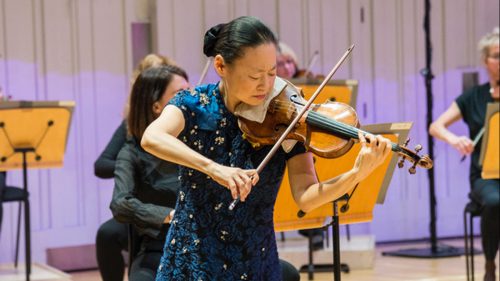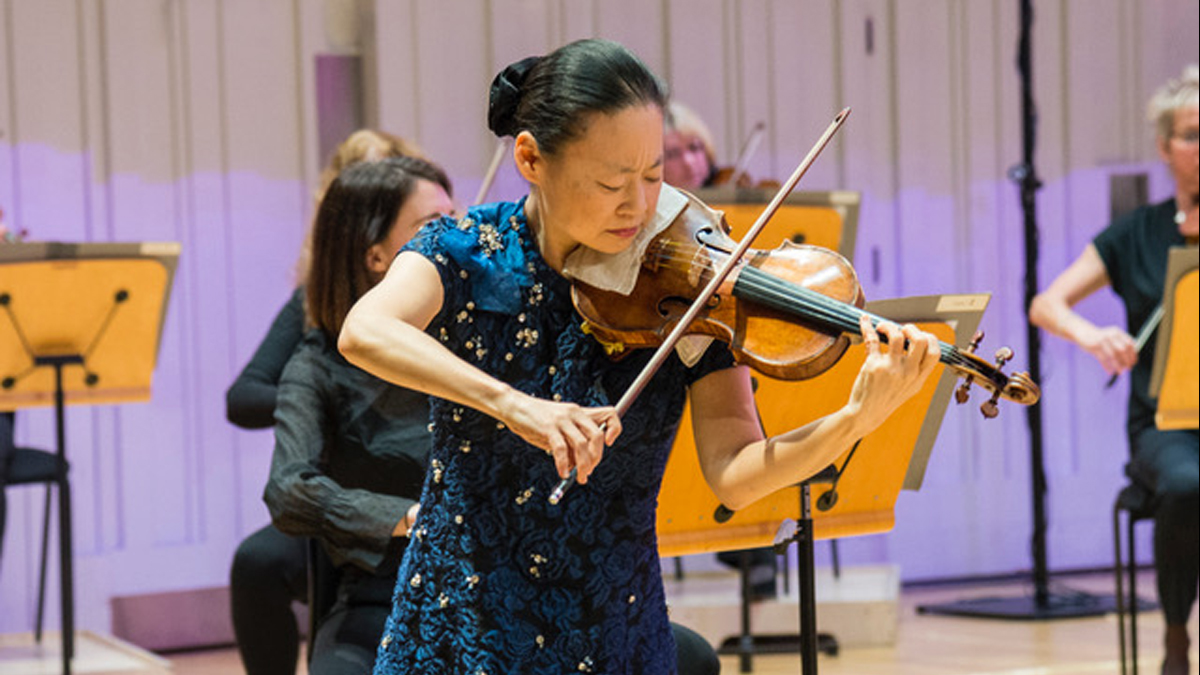 United Kingdom Beethoven: Midori (violin), Royal Scottish National Orchestra / Thomas Søndergård (conductor). Performance from the RSNO Centre Glasgow and reviewed as a live stream, 23.10.2020. (GT)
United Kingdom Beethoven: Midori (violin), Royal Scottish National Orchestra / Thomas Søndergård (conductor). Performance from the RSNO Centre Glasgow and reviewed as a live stream, 23.10.2020. (GT)

Beethoven – Symphony No.1 in C major, Op.21; Violin Concerto in D major, Op.61
This is the second in the Royal Scottish National Orchestra online broadcasts and continuing the celebration of Beethoven’s 250th birth anniversary. The series of Beethoven was interrupted by the pandemic in March following breath-taking performances of the ‘Eroica’ and Seventh Symphonies conducted by Roger Norrington and Elim Chan, respectively. They were momentous in offering unique big band interpretations of these masterpieces.
Only last month, I heard a Russian orchestra take on the Violin Concerto and the Fifth, so this evening was of great interest. I remember Midori’s first visit with this orchestra when she played the Mendelssohn Violin Concerto with Bryden Thomson in the old City Hall. Then, the diminutive Korean was a quite different musician, a teenager still learning the repertoire and displaying her brilliant virtuosity; today, she is a more balanced artist with a greater range of works in her repertoire. This season, she is the RSNO Resident Artist. She plays a 1734 Guarnerius del Gesu ‘ex-Hubermann’ violin. Midori is one of the United Nations Messengers of Peace, she is a fine artist on stage, and hopefully, her tenure here with the RSNO will prove beneficial for young aspiring musicians.
For several years, the RSNO have been arranging digital masterclasses with schools in Scotland, and the decision to provide a limited concert season via the internet to subscribers is a welcome sign during the Covid-19 pandemic. For some years, I have been a regular viewer of the Digital Concert Hall from the Berliner Philharmoniker – so this was an opportunity to sample how we Scots can offer an online concert series. In comparing the sound picture of the Philharmonic Hall acoustic with the actual online sound, the German sound online is excellent in truthfully portraying the clean and bright hall value. Here in Scotland, the orchestra plays in their RSNO Hall that has an improved acoustic to the Royal Concert Hall and has been the venue for their recent chamber concert series. The RSNO online broadcasts employ six cameras offering a pleasantly attractive experience with closeups of the soloist and the conductor. These concerts are available by payment online and are available from the evening they premiere until Sunday 14 March 2021.
This orchestra has developed a distinguished reputation in late romantic and modern repertoire, in recent decades the style of Beethoven performance has changed dramatically for the better, and now the RSNO can offer an alternative to the ‘period’ style of Mozart, Haydn, and Beethoven, but not without concessions. Norrington’s concert of the ‘Eroica’ last season was exciting and revelatory, by the placing of wind players surrounding the strings in the attempt to play Beethoven as it might have been heard 200 years ago.
Thomas Søndergård used a conventional seating plan, and in his previous concert two weeks ago the Danish maestro gave an outstanding reading of Beethoven’s ‘Eroica’ Symphony. The musicians are placed two metres from each other, somewhat more than at Berlin where just a metre or so separates the players. In the Beethoven symphony, the conductor used a full complement of strings, with violins on his left and right, basses on the left, and natural timpani on the far right with natural trumpets – the sole concession to ‘period music’. In the opening movement, Søndergård beautifully handled the transition from Adagio to Allegro, and there was some sparkling virtuosity from the flute of Kathryn Bryan, and oboe of Adrian Wilson. The orchestral playing was impressive, wonderfully clear with strength and elegance. In the Andante, the conductor carefully developed the graceful stepping idea, fugally – bringing a wonderfully idyllic picture. A feature of this broadcast was seeing the closeups of musicians – something one misses in live concert performances. The Minuetto, more like a scherzo, was fittingly lively, with brusque sforzati very well executed, and the Trio providing a fine contrast to this ‘scherzo’. The finale was suitably jocular where it needed to be, and the violins led by Maya Iwabuchi were on top form – the clean acoustics allowed every musician freedom to express themselves.
The Violin Concerto’s great opening movement was very measured with the opening four beats from the timpani, and the mood breathing an air of peace and humanity. Midori is very intense, and in the closeups, we could see the music’s passion etched on her face – she looks like a wise lady – as if a storyteller from the East. Her playing was very sophisticated, and the clean acoustics allowed more detail to be heard. In the Allegro ma non troppo, we heard a cornucopia of melodic ideas, harmonious perfection, and the hymn-like song of the second theme was marvellous in leading to the beautiful cadenza by Midori – sounding like a transfiguration of peace. She was shadowed by wonderful playing from David Hubbard on the bassoon. In the Larghetto, a more lyrical theme from Midori was picked up with graceful poise by the violins, and the sensitive and heavenly clarinet of Timothy Orpen. In the Rondo. Allegro finale, the mood was bright, energetic, and heroic, with Midori’s glittering buoyant runs bringing a celebratory close. This performance was the finest I have heard since Anne-Sophie Mutter’s concert here two years ago. The challenge of Beethoven is being taken up vigorously by the RSNO and one awaits their further concerts keenly.
Gregor Tassie
For more about the RNSO click here.
